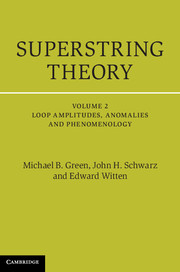Book contents
- Frontmatter
- Contents
- Preface to the 25th Anniversary Edition
- 8 One-loop diagrams in the bosonic string theory
- 9 One-loop diagrams in superstring theory
- 10 The gauge anomaly in type I superstring theory
- 11 Functional methods in the light-cone gauge
- 12 Some differential geometry
- 13 Low-energy effective action
- 14 Compactification of higher dimensions
- 15 Some algebraic geometry
- 16 Models of low-energy supersymmetry
- Bibliography
- References
- String Field Theory
- Index
9 - One-loop diagrams in superstring theory
Published online by Cambridge University Press: 05 September 2012
- Frontmatter
- Contents
- Preface to the 25th Anniversary Edition
- 8 One-loop diagrams in the bosonic string theory
- 9 One-loop diagrams in superstring theory
- 10 The gauge anomaly in type I superstring theory
- 11 Functional methods in the light-cone gauge
- 12 Some differential geometry
- 13 Low-energy effective action
- 14 Compactification of higher dimensions
- 15 Some algebraic geometry
- 16 Models of low-energy supersymmetry
- Bibliography
- References
- String Field Theory
- Index
Summary
In this chapter we discuss one-loop amplitudes in superstring theory. The operator methods used for the calculations of one-loop amplitudes with on-shell external states in chapter 8 will be applied to the calculation of the corresponding diagrams in superstring theories. The resulting amplitudes are expressed as integrals over world sheets that are closed and orientable in the case of the type II or heterotic theories. Type I theories are based on unoriented open and closed strings, and as a result their world sheets need not be orientable and can have boundaries. As in the case of the bosonic theory, the operator approach automatically gives the correct measure factors by elementary algebraic manipulations. In approaches that explicitly compute the sum over geometries, considerable care is required to correctly define and evaluate infinite determinants that give the measure. Nonetheless, such approaches have a number of advantages and certainly appear preferable for the study of multiloop amplitudes.
In the case of one-loop amplitudes in superstring theories, the light-cone gauge calculations based on the space-time supersymmetric formalism of chapter 5 and covariant calculations based on the formalism with worldsheet supersymmetry of chapter 4 are quite different, just as in the case of the calculation of the tree diagrams. For many purposes the light-cone method with manifest space-time supersymmetry is more economical, because there are fewer diagrams to calculate for a given process. For example, in theories with oriented closed strings (type II and heterotic) there is only one one-loop diagram, which corresponds to a world sheet that is topologically a torus.
- Type
- Chapter
- Information
- Superstring Theory25th Anniversary Edition, pp. 75 - 140Publisher: Cambridge University PressPrint publication year: 2012



